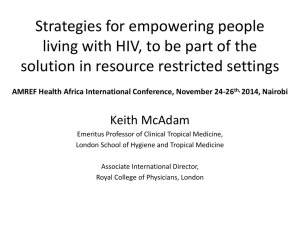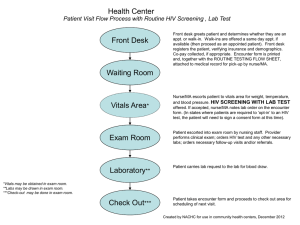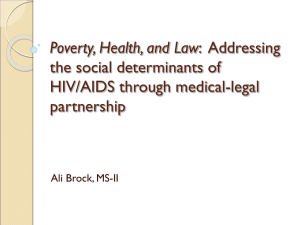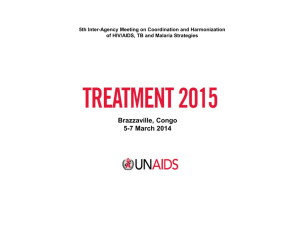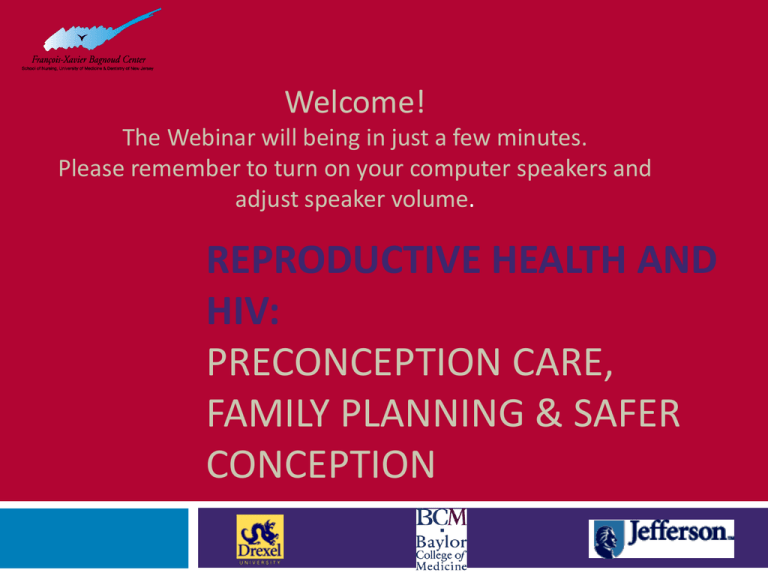
Welcome!
The Webinar will being in just a few minutes.
Please remember to turn on your computer speakers and
adjust speaker volume.
REPRODUCTIVE HEALTH AND
HIV:
PRECONCEPTION CARE,
FAMILY PLANNING & SAFER
CONCEPTION
This teleconference is made possible by the
Cooperative Agreement #5U65PS000815-03 from
the Centers for Disease Control and Prevention
Special thanks to AETC, Title X and CDC EMCT partners
The views expressed by the speakers and moderators do not
necessarily reflect the official polices of the Dept. of Health and
Human Services nor does mention of trade names or
organizations imply endorsement by the U.S. Government.
Webinar schedule
Session 1: Preconception Care in the Setting of HIV
Infection
Session 2: Contraceptive care for
women/couples living with HIV infection
Session 3: Safer conception for HIV-discordant
couples
Navigating the Webinar
Three short videos will be shown during the webinar
Please close other applications on your computer
At times during the webinar, we will ask poll
questions
A separate window will show the questions
Choose your response
Responses will be displayed after you vote
Please type your questions or comments for the
speakers in the chat box at the bottom right of your
screen.
Materials and Evaluation
Participants will receive and e-mail with links to the webinar
recording, slide set, support tools and evaluation survey
The link for the evaluation survey is available in the chat box
If you did not register for this event, please send your name
and e-mail address to phillijm@umdnj.edu
Preconception care in the setting of HIV
infection
William Short MD, MPH
Assistant Professor of Medicine, Division of Infectious
Diseases
Jefferson Medical College of Thomas Jefferson University
William.Short@jefferson.edu
Module objectives
Explain the goals and discuss the importance of
preconception care in the context of HIV.
Demonstrate preconception counseling for women
and couples with HIV, including special
considerations for preconception counseling for HIVinfected men.
Describe preconception assessment and
interventions for women living with HIV.
Module objectives
Explain the role of the HIV primary care provider in
preconception counseling and care
Discuss models of integration of preconception
care
Case study
Gloria is a 32 year old HIV+ AA female
HIV acquired from a previous boyfriend
No significant medical history/on no medication
CD4 380 and viral load is 24,000
She is returning for her 2nd visit to discuss ART
Role Play
Poll
amfAR, n=4831 US adults
email survey (2008)
HIV+ women internalize stigma around
conception
Women Living Positive Survey
n=700 HIV+ women on ARVs for 3+ yrs
59-61% believed could have children if appropriate care
59% believed society strongly urges not to have children
Caucasian (67%) vs. Hispanic (53%), (p < 0.05)
South (66%) vs. Northeast (52%) or Midwest (55%), (p < 0.05)
ID (62%) vs. FP/GP (62%) vs. NP or PA care (48%) (p < 0.05)
Squires et al. (2011) AIDS patient care and STDs
Fertility desires and intentions
Studies of fertility desires and intentions have
consistently shown that many women living with HIV
want to have children.
Survey of >1400 HIV+ adults in care in 1998:
28% of bisex/heterosex men
29% of women want children in future
Survey of 450 HIV+ women in the UK in 2011
75% stated they wanted more children
Fertility desires and intentions
Factors
Associated with fertility desires
Positive influence
Negative influence
•
•
•
•
•
•
•
•
•
•
Younger age
No children
Antiretroviral therapy
Interventions for PMTCT
Partner’s/family
members’ wish for
children
• HIV-related stigma
Already having one or more children
Personal health concerns
Concerns about infecting partner
Concerns about infecting child
Negative or judgmental attitudes of
health workers, family
• HIV-related stigma
Contraceptive Use Among US Women with HIV
Women's
Interagency HIV
Study (WIHS):
In over 30% of
these visits, HIVinfected women
reported not
using any form of
contraception.
Massad et al. (2007)
J Women’s Health
Estimated # of births to women with HIV
9000
8500
8000
7500
7000
6500
6000
5500
2000
2001
2002
2003
High Estimate
2004
2005
2006
Low Estimate
Fleming (2002) Office of Inspector General
Whitmore, et al. (2009) CROI
Live birth rates among HIV+ women before
and after HAART availability
Comparison of live birth rates 1994-1995 (pre-HAART
era) and 2001-2002 (HAART era) in HIV+ and HIVwomen 15-44 years
Largest difference (306% increase) was seen in women
>35 years old
In HAART era, 150% increase in live birth rate among
HIV+ women vs. 5% increase among HIV- women
Sharma, et al. AJOG 2007
Preconception care
“Interventions that aim to identify and modify
biomedical, behavioral and socials risks to a
women’s health or pregnancy outcomes through
prevention and management”
Early prenatal care is not enough
CDC. MMWR 2006;55:1-23
Goals of preconception care in
the context of HIV infection
Prevent unintended pregnancy
Prevent HIV transmission to partner
Optimize maternal & paternal health
Improve maternal and fetal outcomes
Prevent perinatal HIV transmission
ACOG Practice Bulletin No 117; December, 2010
Importance of preconception care
Women and men living with HIV want to have children.
Many pregnancies among HIV-infected women are unintended.
Contraception is under utilized, including men in the
conversation.
Women and men face barriers related to stigma and conception
with serodiscordant partners
Preconception counseling and care not addressed pro-actively
Reproductive health care often not a priority for patients or
providers
Unintended pregnancy
US general population
US,
232 HIV+ women
WIHS
49% pregnancies unintended
77% pregnancies while using
contraception (vs. 60% HIV-)
US
83.3% unplanned
49-52% HIV status known
57.6% unplanned
Italy
1090 HIV+
adolescents
334 HIV+ on ARV
Finer and Henshaw (2006) Perspec Sex Repro Health; Massad (2004) AIDS
Koenig (2007) AJOG ; Floridia (2006) Antivir Ther
Are HIV providers discussing reproductive
desires?
Women Living Positive Survey (n=700, ARVs for 3+
years)
48%
previously pregnant or considering pregnancy
were never asked about their pregnancy intentions
(n=227)
57% currently or previously pregnant or considering
pregnancy had not discussed treatment options
(n=239)
Every interaction is an opportunity
To discuss HIV status or testing
To discuss reproductive health desires
Preconception
Contraception
Safer conception
The stories in our lives do not always coincide with the
reminders in the medical health record.
Start the conversation. Stay open. Repeat.
Primary HIV care includes reproductive
health
If we succeed at integrating preconception and
family planning into primary care model
Every
HIV-exposed pregnancy will be planned and well-
timed
There will be no HIV transmission to infants or to
uninfected partners
The health of all HIV-affected parents and infants will be
optimized
Squires et al (2011) AIDS pt care and STDs
Establish reproductive desires
WHO?
Every
reproductive-aged woman and man
Even if they do not have a current sexual partner
WHEN?
At
initial evaluation
Intervals throughout the course of care
Conduct preconception counseling
Conduct preconception counseling when:
There
is an expressed interest in conceiving
There is nonuse/inadequate use of effective
contraception
There is a change in relationship or personal
circumstances
Conduct preconception counseling
Conduct preconception counseling when:
She
is taking medications with potential reproductive
toxicity or interaction with hormonal contraception
She is at risk for unintended pregnancy
There is new information about pregnancy and HIV
She plans enrollment in a clinical trial
Conduct preconception counseling
Impact of pregnancy on
HIV and impact of HIV on
pregnancy
Risk factors for MTCT and
strategies to reduce
those risks
ARV medications
C-section
Avoidance of BF
Risks/benefits of HIVrelated medications
Disclosure of HIV
diagnosis
Partner testing
Safer conception
options
Conduct preconception counseling
Address alcohol, drugs and/or tobacco use
Recommend avoidance of OTCs
Consider delaying pregnancy until health is optimized
Optimize preconception health
Screen for:
Syphilis
Provide:
Refer for:
Genetic screening, based on
history
Contraception, as needed,
to delay pregnancy while
health issues are addressed
Folic acid 400 mcg daily
Immunizations, as
needed, for:
hepatitis B
rubella
varicella
Optimize preconception health
Perform clinical staging, CD4 testing and viral load as indicated
Assess and treat opportunistic infections
Assess need for prophylaxis against OIs
Optimize treatment/control of other chronic diseases
Review all medications for safety in pregnancy
Consider ARV treatment
Initiate/modify ARV treatment for women who need it for
their own health:
Consider the regimen’s effectiveness for treatment of HIV,
hepatitis B disease status, potential for teratogenicity and
possible adverse outcomes .
Adjust ARV regimens to exclude efavirenz or other drugs with
teratogenic potential during the preconception period.
How can preconception care be
integrated into the HIV primary care
setting?
Integrating preconception and HIV care
Challenges:
Lack of comfort and/or knowledge
Actual or perceived lower level of priority compared to other
issues
Time constraints
Role of the primary care provider not entirely clear
Integrating preconception and HIV care
Co-locate/integrate OB-GYN and HIV services
Develop collaborative relationships, bilateral
communication, formal linkages, referral indications and
practice guidelines
Consider development of a peer educator program
Integrating preconception and HIV care
Provide training and support
Guidelines: Perinatal HIV guidelines and ACOG practice
bulletin clearly describe components of preconception
care
Training curriculum and job aids: Links to materials will
be sent to webinar participants
Integrating preconception and HIV care
Simplify approach by emphasizing core principles:
Ask clients of reproductive age about their reproductive plans
Discuss the importance of planning for pregnancy to ensuring
preconception health/safer conception
Ensure contraceptive needs are met
Develop a preconception plan for women/couples who want to
become pregnant or who are not using adequate contraception
Integrating preconception and HIV care
An informational
brochure for clients
on preconception
health and the
importance of
preconception care
Integrating preconception and HIV care
Guide to
preconception
counseling for
the HIV care
provider
Questions and Comments*
*Type in the chat box and then click “Enter”
Contraceptive Care for Women with
HIV Infection and their Partners
Kimberly McClellan, MSN, WHNP-BC, CRNP
Director Women's Health
AIDS Care Group, Chester PA
ksv23@drexel.edu
Objectives
Describe considerations for selecting appropriate
contraceptive and compare options for women living
with HIV
Explain specific consideration related to hormonal
contraception and antiretroviral treatment
Identify issue related to hormonal contraception and
HIV progression, transmission or acquisition
Case study
One year later:
Gloria initiated ATV/r + TDF/FTC combination therapy
and has achieved viral suppression with CD4 count of
500
She is here for a routine visit and is doing well
Role Play
Poll
Benefits of Contraception for HIV-Positive
Women
Prevents unintended pregnancy
Half
of all pregnancies in U.S. are unintended
Allows women to plan a pregnancy that
Is
well timed
Occurs in optimal health
Minimizes risks for perinatal transmission
Special Considerations Regarding HIV
and Contraception
Potential drug interaction with antiretrovirals (ARVs)
Possible effects on HIV transmission
Possible effects on HIV acquisition
Possible effects on HIV progression
Typical Effectiveness of Contraception
HIV-positive
women generally
have the same
options as
uninfected women
US Medical Eligibility Criteria for
Contraceptive Use
US Medical Eligibility Criteria: Categories
Oral contraceptives
Same medical criteria as for HIV-uninfected
women if woman is NOT on ART
Drug-drug interactions are possible between ARVs
and hormonal contraceptives (HCs)
HCs are metabolized by same pathways and cytochrome
P450 enzymes as many PIs and NNRTIs
These interactions can cause changes in the efficacy of
the ARV or contraception
ACOG (2010), Gynecologic care for women with human
immunodeficiency virus. Practice Bulletin #117.
Hormonal Contraception: Alternate
Delivery Methods
Combined Patch is a thin
plastic square worn on body
Releases estrogen and
progestin through the skin
Works by preventing
ovulation
Efficacy
Limited research suggests
may be more effective than
COCs
Decreased efficacy in women
over 90 kg
Hormonal Contraception: Alternate
Delivery Methods
Limited research suggests health risks and benefits are
similar to COCs
Side Effects
Skin irritation or rash where patch is applied
Changes in bleeding pattern
Headaches
Nausea
Vomiting
Breast tenderness
Abdominal pain
Hormonal Contraception: Alternate
Delivery Methods
Combined Vaginal Ring is
placed into the vagina
Releases estrogen and
progestin
Works by preventing ovulation
Efficacy
Limited research suggests may
be more effective at preventing
pregnancy than COCs
Alternative Delivery Methods
Limited research suggests risks and benefits similar to
COCs
Side effects
Changes in bleeding pattern
Headaches
Nausea
Breast tenderness
Vaginitis
Leukorrhea/increase in Lactobacillus
Alternate Delivery Methods
These delivery methods also vulnerable to drug
interactions
One small study found significant interaction between
the estrogen and progestin hormones of the patch and
lopinavir/ritonavir
More research needed on these delivery methods
DMPA
Injectable (IM,SQ) progestin only
contraception
Given every 3 months
Works by preventing ovulation
Efficacy
97% effective as commonly used
Over 99% effective when used as
directed (3 pregnancies per 1000
women)
Contraceptive Implants
Thin rods or tubes
containing a progestin
hormone.
Provide effective
contraception for at least
3 yrs.
Suppresses ovulation and
changes cervical mucus.
Menstrual irregularities in
most users.
Intrauterine devices (IUDs)
No known drug interactions
No increase in shedding of HIV
2 types
Copper (Paragard) works for 10 years,
may be associated with heavier
menses, periods regular)
Levonorgestrel IUD (Mirena) works for
5 years, reduces menstrual blood loss
(is FDA-approved as a treatment for
menorrhagia), periods scant and not
regular
Medical Eligibility Criteria for IUD*
LNG-IUD
LNG-IUD
Cu-IUD
Cu-IUD
Initiation
Continuation
Initiation
Continuation
High Risk for HIV
2
2
2
2
HIV Infection
2
2
2
2
AIDS
3
2
3
2
Clinically Well on
ARV Therapy
2
2
2
2
*Adapted from: U.S. medical eligibility criteria for contraceptive use.
Category 2: A condition for which the advantages of using the method generally outweigh
the theoretical or proven risks.
Category 3: A condition for which the theoretical or proven risks usually outweigh the
advantages of using the method.
IUD and HIV Considerations
No higher risk in HIV-positive women over
uninfected women for
Complications
Infections
IUD use not associated with increased risk for
transmission to sex partners
Women with IUD in place who develop AIDS should
be monitored for pelvic infection
Hormonal Contraception and NNRTI
Interaction Table
No effect on oral ethinyl estradiol
Decreased active metabolites of
norgestimate (levonorgestrel AUC
↓ 83%; norelgestromin ↓64%)
A reliable method of barrier
contraception must be used in addition
to HC due to decreases in progestin
levels.
Implant: ↓ etonogestrel
A reliable method of barrier
contraception must be used due to
reports of contraceptive failure.
Levonorgestrel AUC ↓58%
Effectiveness of emergency
contraception may be diminished
Etravirine (ETR)
Ethinyl estradiol AUC ↑22%
Norethindrone: no significant
effect
No dosage adjustment necessary
Nevirapine (NVP)
Ethinyl estradiol AUC ↓20%
Norethindrone AUC ↓19%
Use alternative or additional methods
Efavirenz (EFV)
No dosage adjustment needed
DMPA: no significant change
Hormonal Contraception and Ritonavirboosted PI Table
Atazanavir/ritonavir (ATV/r)
↓ Ethinyl estradiol
↑ Norgestimate
Oral contraceptive should contain
at least 35 mcg of ethinyl
estradiol. OCs containing
progestins other than
norethindrone or norgestimate
have not been studied.
Darunavir/ritonavir (DRV/r)
Ethinyl estradiol ↓44%
Norethindrone AUC ↓14%
Use alternative or additional
method.
Fosamprenavir/ritonavir (FPV/r)
Ethinyl estradiol AUC ↓ 37%
Norethindrone AUC ↓34%
Use alternative or additional
method.
Lopinavir/ritonavir (LPV/r)
Ethinyl estradiol AUC ↓42%
Norethindrone AUC ↓17%
Use alternative or additional
method.
Saquinavir/ritonavir (SQV/r)
↓Ethinyl estradiol
Use alternative or additional
method.
Tipranavir/ritonavir (TPV/r)
Ethinyl estradiol AUC ↓48%
Norethindrone: no significant
change
Use alternative or additional
method.
Hormonal Contraception and PIs without
Ritonavir Table
Atazanavir (ATV)
Ethinyl estradiol AUC ↑48%
Norethindrone AUC ↑110%
Oral contraceptive should contain
no more than 30 mcg of ethinyl
estradiol or use alternative
method. OCs containing less than
25 mcg of ethinyl estradiol or
progestins other than
norethindrone or norgestimate
have not been studied.
Fosamprenavir (FPV)
With APV: ↑Ethinyl estradiol and
↑norethindrone; ↓APV 20%
Use alternative method.
Indinavir (IDV)
Ethinyl estradiol AUC ↑25%
Norethindrone AUC ↑26%
No dose adjustment.
Nelfinavir
Ethinyl estradiol AUC ↓47%
Norethindrone ↓18%
Use alternative or additional
method.
Adapted from: Recommendations for use of antiretroviral drugs in pregnant HIV-1-infected women
for maternal health and interventions to reduce perinatal HIV transmission in the United States.
http://aidsinfo.nih.gov/ContentFiles/PerinatalGL.pdf
Hormonal Contraception and CCR5
antagonist/integrase inhibitor table
CCR5 antagonist
Maraviroc (MVC)
No significant effect on
ethinyl estradiol of
levonorgestrel
Safe to use in
combination
No significant drug effect
No dose adjustment
necessary
Integrase inhibitor
Raltegravir
Adapted from: Recommendations for use of antiretroviral drugs in pregnant HIV-1-infected women
for maternal health and interventions to reduce perinatal HIV transmission in the United States.
http://aidsinfo.nih.gov/ContentFiles/PerinatalGL.pdf
Condoms
Efficacy
Pregnancy prevention as commonly used
Pregnancy prevention when used correctly and consistently
Male condom 85%
Female condom 79%
Male condom 98%
Female condom 95%
Male condom is 80-95% effective at preventing HIV
transmission when used correctly and consistently
Dual Contraceptive Use
Condom use should be encouraged for women
To prevent HIV/STI acquisition
Condom use should be encouraged in HIV-positive
women
To prevent HIV transmission
Prevent STI acquisition
As an adjuvant to contraceptives
Condoms alone have a failure rate of 15%-21% at
preventing pregnancy
Spermicides: Not recommended
Spermicides are not recommended by CDC
Disrupt cervical mucosa
Potentially increase viral shedding
Increase transmission of HIV to uninfected partners
Diaphragms and cervical caps are not encouraged by
the CDC due to concerns about their use with
spermicides
Female and Male Sterilization
Contraceptive sterilization is Male-vasectomy:
the most widely used
Cutting/occluding both vas
method of family planning
deferens
Clients should be advised
that sterilization should be
considered permanent
1st yr failure rate-0%-0.5%
Female-sterilization
Transabdominal
Transcervical
Tubal sterilization
Occlusion method
Hormonal Contraception and HIV Acquisition:
WHO Technical Statement
Most studies found no statistically significant association
between oral contraception and HIV acquisition
Evidence on injectable HC varied with some studies
showing increases between 48% to 100% and other studies
reporting no association
Due to inconsistent data and limitations of the studies
performed WHO rated the current evidence as low
HIV Transmission and Hormonal Contraception:
WHO Technical Statement
Recent observational study found a 2-3 increase in HIV
transmission in women using injectables over oral contraception
Findings from studies assessing HC and genital HIV shedding are
not consistent
Studies assessing HC and viral load generally showed no negative
effect
WHO rates the evidence for HIV transmission and injectable
use as low and HIV transmission and oral contraception as very
low
HIV Disease Progression and Hormonal Contraception:
WHO Technical Statement
None of the 10 observational studies conducted found a
significant association between hormonal contraception and
HIV progression
One randomized controlled trial found an increased risk of
progression for HC users compared to copper IUD users
Due to flaws in this study --- high rates of method switching and
loss to follow-up --- the evidence for HC and HIV progression is
rated as low
WHO Recommendations
No restriction on the use of any hormonal contraceptive method for
HIV-positive women or women at high risk for HIV infection
Critical importance must be placed on the consistent and correct use
of condoms for the prevention of HIV acquisition or transmission
Most concern is focused on the evidence of HIV acquisition and DMPA
because a causal relationship is neither established nor ruled out
Voluntary use of contraception by HIV positive women who wish to
prevent pregnancy continues to be an important PMTCT strategy
Questions and Comments*
*Type in the chat box and then click “Enter”
Safer Conception for Sero-Discordant
Couples
Judy Levison, MD, MPH
Associate Professor, Departments of Obstetrics and
Gynecology and Family and Community Medicine
Baylor College of Medicine
Houston, Texas
jlevison@bcm.edu
Objectives
Describe two methods of conception for an HIV+
woman and an HIV- man
List three methods of conception for an HIV+ man
and an HIV- woman
The Serodiscordant Couple
HIV discordance in couples
Population based sample of HIV infected persons in care
58% of men and 70% of women had a primary partner
50% of couples were in serodiscordant relationships
20% were in relationships with partners whose HIV status was
unknown
Family Planning Perspectives, 33 (4); 144-52, 2001
Estimated 140,000 serodiscordant heterosexual couples
in the U.S., about half of whom want children
Am Journal of Obst and Gyn, 204(6), 488e1-8, 2011
Case presentation
Two years later:
Gloria continues to do well on her combination
regime and maintains an undetectable viral load. At
this appointment she seems anxious to discuss some
big news.
Role Play
Poll
The first two responses may have been appropriate
before we saw the successes of the HAART era
But in 2012:
Perinatal transmission is <1-2%
Men and women with HIV can expect to live to see their
children grow into adulthood
Preconception counseling
If a woman is not on ARVs, consider starting them prior
to attempting conception
If a woman is on ARVs and is considering pregnancy
Substitute other ARVs for efavirenz (Sustiva) because of
possible risk of neural tube defects (NTDs)
Recommend folate or prenatal vitamins preconceptionally to
reduce chance of NTDs
Serodiscordant couples
If the woman is HIV+ and the man is HIV-,
discuss the options of:
Ovulation
predictor kits
Home insemination (“turkey baster method”)
Ovulation predictor kits
These test kits replace the old basal body
temperature charts
When the time is right, the choices are:
Home insemination with partner’s semen
The “turkey baster” method
*A needle-less syringe works fine
Home insemination
During the 24 hours after the LH surge has occurred as
documented by the ovulation predictor kit, ejaculate
into a cup or into a condom without a spermicide
Suction semen into a syringe
Place syringe in vagina and deposit semen
Remain lying down for 20 minutes
Return to having protected sex with condoms
Alternatives
Insemination in a doctor’s office with partner’s semen
Penile/vaginal intercourse only during the 24 hours after
the LH surge and using condoms the rest of the month.
Placing the woman on ARVs prior to attempted conception
will further protect her partner
Post or pre-exposure prophylaxis for male (PEP or PrEP)? If
yes, how many doses?
Baeten, J. and Celum, C. (2011)
The Partners PrEP Study. Int. AIDS Society, Rome
And one more word about condoms…
If we do not broaden our discussions around
reproductive health (leaving it at "use condoms“),
many individuals will do what they will do at home in
order to achieve pregnancy
It’s much better that they conceive with support and
knowledge of safe options. We don’t want clients to
feel they have to hide their desire to have children.
Serodiscordance
If the man is HIV+ and the woman is HIV-, consider:
Maximal viral suppression of the male
Ovulation predictor kit/ timed insemination with washed
sperm
Intracytoplasmic sperm injection (ICSI)
Ovulation predictor kit/timed intercourse
Post-exposure prophylaxis (PEP) or pre-exposure prophylaxis
(PrEP) for female
Donor insemination
Sperm washing
Cost is in the $1500 range
Not widely available
http://aids.about.com/cs/womensresources/a/washing.htm
http://www.thebody.com/content/art911.html
Has the time come for natural conception in the
context of full viral suppression?
Barreiro
62 serodiscordant couples
HIV+ partner on ART and VL < 500
No transmission of HIV
HPTN 052
96% reduction in transmission of HIV among serodiscordant
couples (ARVs started if CD4 350-500)
Barreiro et al. (2007) Human Reproduction, 22 (9), 2353
Cohen, M. et al. (2011). NEJM 365: 493-505.
What if both partners are HIV-positive?
When a couple is not attempting conception, we
recommend condoms to avoid superinfection and
sharing of antiretroviral resistant virus
If pregnancy desired: Ovulation predictor kit,
maintaining an undetectable viral load, and once
monthly unprotected sex is a reasonable approach
Preconception counseling is not being addressed
Data suggests that reproductive counseling does not
often occur until after conception
Recent
study of 181 women: Only 31% reported a
personalized discussion with their provider specific to
their childbearing plans.
Of those who had a personalized discussion, most were
initiated by the client rather than the provider.
S. Finocchario-Kessler, et al., AIDS Patient Care and STDS,
24(5), 317-23, 2010
Support Tools: EPIC Template
Are you interested in having a child?
When do you wish to conceive?
Are you currently using condoms?
Are you currently using contraceptive other than condoms?
Currently 6 mos-1yr, 1-2 years; >2years
If yes, what method:
If no, are you seeking pregnancy:
Would you like information on planning a safe pregnancy that
may reduce the risk of HIV transmission to your partner and your
baby?
Support Tools: EPIC Template
Do you know and understand your CD4 count and viral load?
Do you understand the importance of being in optimal health
before becoming pregnant?
Counseling elements when definitely considering pregnancy:
Antiretroviral medications that are not recommended in pregnancy
(e.g. EFV)
Options for discordant couples:
Referral to Women’s Service: Preconception Counseling
Final notes on preconception counseling…
Contraception and pregnancy desires change over time.
Just because someone did not desire pregnancy in 2011
does not tell you what he or she wants in 2013.
Don’t forget to ask the men if they and their partners
are planning a pregnancy. Let them know that there are
preconception counseling services available.
Questions and Comments*
*Type in the chat box and then click “Enter”
Thank you!
Participants will receive and e-mail with links to the webinar
recording, slide set and support tools
Please visit this link to submit your evaluation:
https://www.surveymonkey.com/s/preconception2012
If you did not register for this event, please send your name
and e-mail address to phillijm@umdnj.edu


